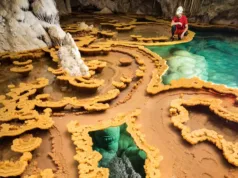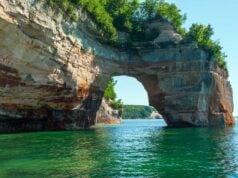The Cheltenham Badlands, located in Ontario, Canada, is a striking and unique geographical feature that has captured the attention of locals, tourists, geologists, and nature enthusiasts alike. This distinct landscape stands as a testament to the powerful forces of erosion and the beauty they can create. Situated within the Caledon Hills near the town of Cheltenham, the Badlands offer a captivating blend of colors and textures that set them apart from the surrounding natural environment.
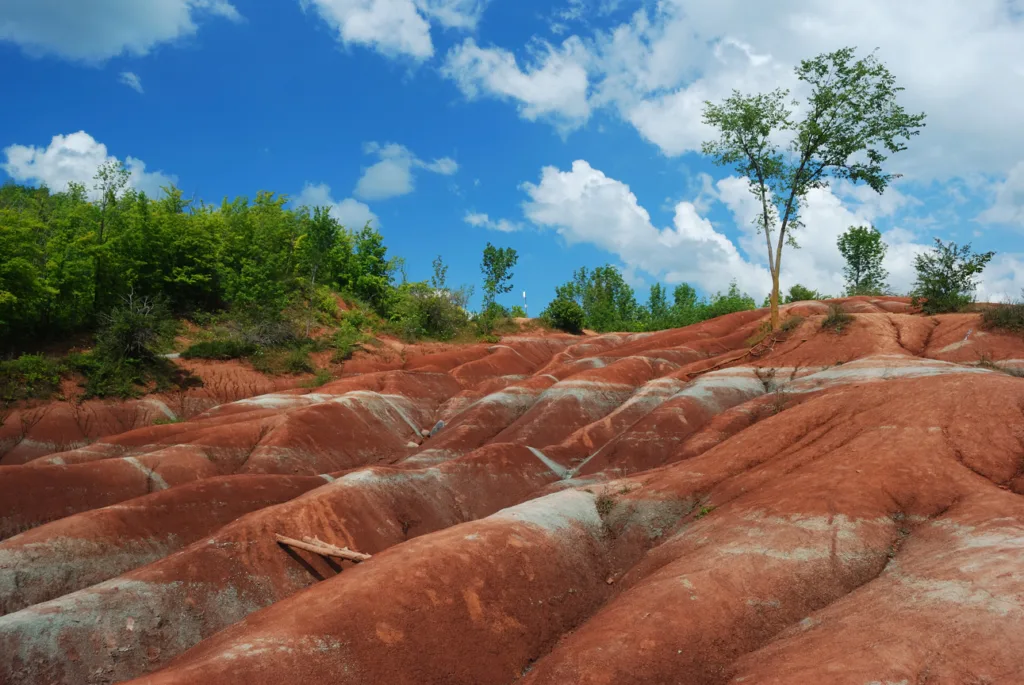
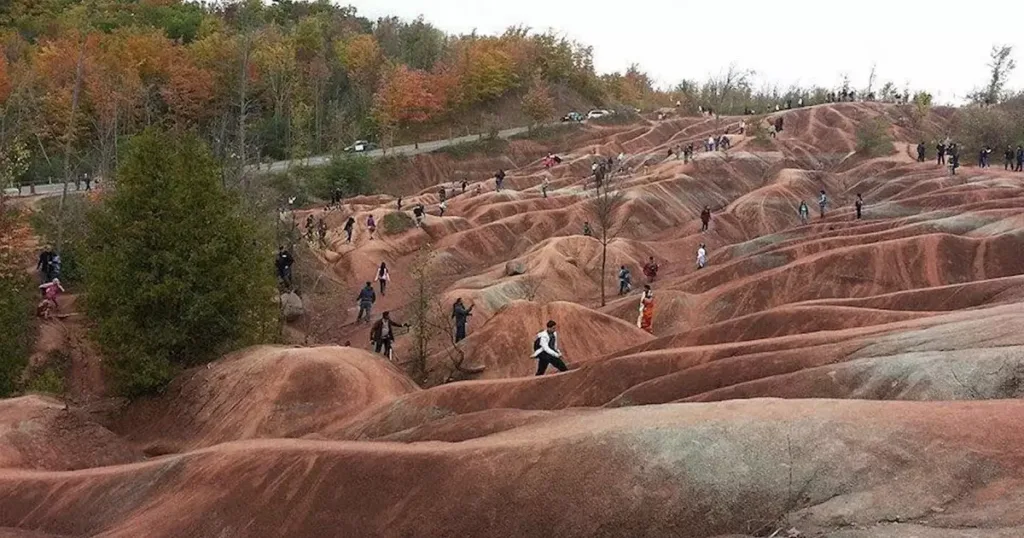
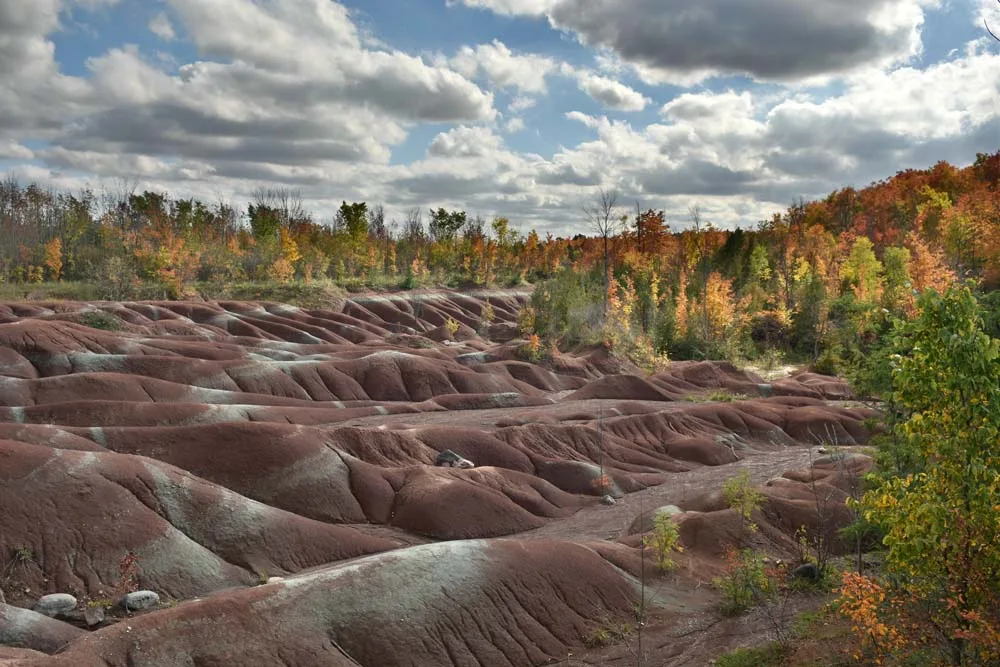
Location: Cheltenham Badlands is situated in the southern part of Ontario, Canada. Specifically, it lies within the Caledon Hills in the town of Caledon, near the community of Cheltenham. The area is easily accessible from major cities like Toronto, making it a popular destination for day trips and nature exploration.
Distinct Landscape Features: The Cheltenham Badlands are characterized by their unique and otherworldly appearance. The landscape features a series of rolling hills and valleys marked by striking bands of red, orange, and greenish-gray sedimentary rock. These bands are the result of millions of years of geological history and the erosion of the underlying Queenston Shale formation.
The distinct coloration of the Badlands is due to the presence of iron oxide (rust) within the rock layers, which oxidizes and gives the hills their vibrant hues. The eroded landscape reveals intricate patterns, ridges, and gullies that create a visually captivating scene, resembling a desert-like terrain in the midst of Ontario’s greenery.
Over time, the elements have sculpted the soft shale rock into a delicate and fragile landscape, making it a prime example of how natural forces shape the Earth’s surface. However, the fragility of the landscape also means that it is sensitive to the impacts of human activity and weathering.
In recent years, the Cheltenham Badlands have gained attention not only for their geological significance but also for their ecological importance and cultural value. As a result, efforts have been made to balance the preservation of this unique landscape with sustainable tourism and educational opportunities.
In conclusion, the Cheltenham Badlands in Ontario, Canada, offer a fascinating glimpse into the power of erosion and the beauty it can create. This unique landscape’s vibrant colors, distinct patterns, and geological history make it a noteworthy destination for those interested in the Earth’s natural processes and the delicate balance between preservation and human interaction.
Formation and Geological History of Cheltenham Badlands
The Cheltenham Badlands were formed through a complex process of erosion, spanning millions of years, that has gradually shaped the landscape into the distinct and visually captivating terrain we see today. The following explanation outlines the key stages of the Badlands’ formation:
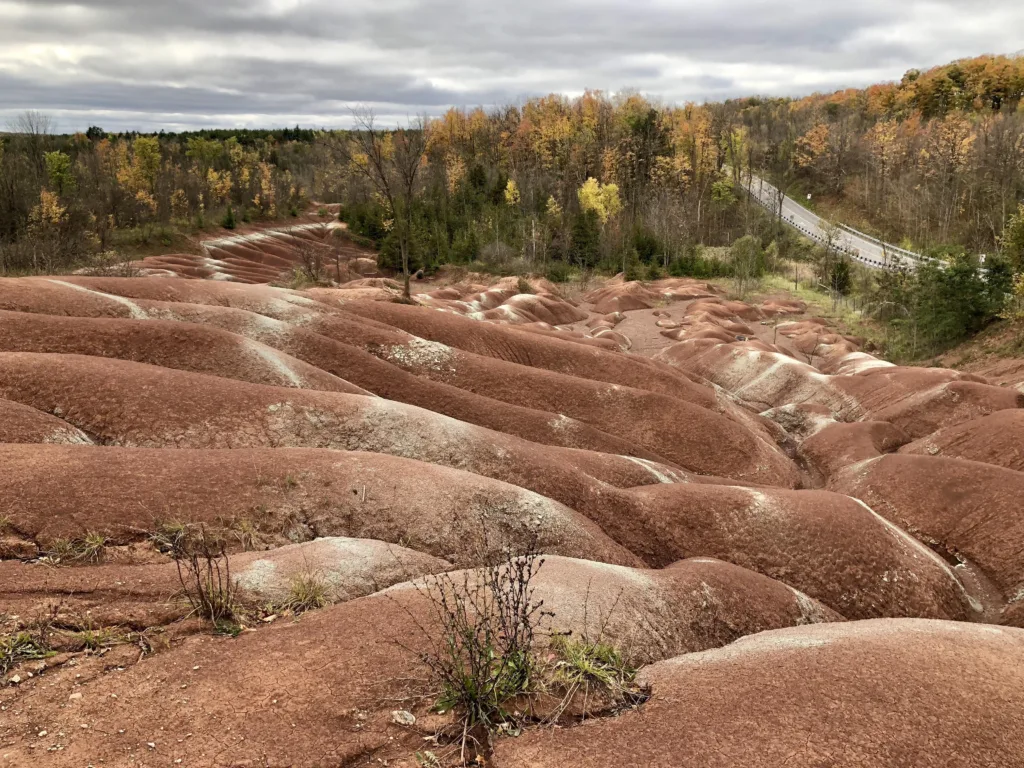
- Deposition of Sediments: The geological history of the Badlands begins with the deposition of sediments in an ancient sea or lake environment. Over millions of years, layers of fine-grained sediment, primarily composed of clay and silt, accumulated at the bottom of this water body.
- Compaction and Lithification: Over time, the weight of the accumulating sediments led to compaction and the gradual transformation of the sediments into sedimentary rock. This process, known as lithification, resulted in the formation of rock layers called strata.
- Tectonic Uplift and Erosion: The Cheltenham Badlands were uplifted due to tectonic forces, exposing the once-buried sedimentary rocks to the elements. This uplift exposed the Queenston Shale formation, which is the underlying rock layer responsible for the unique landscape.
- Erosion by Water and Wind: The Badlands’ distinct appearance is primarily a result of water and wind erosion. The Queenston Shale, composed of fine-grained and easily erodible rock, was susceptible to the forces of weathering and erosion. Rainwater and runoff gradually wore away the shale, forming intricate patterns of ridges and valleys.
Underlying Geology (Queenston Shale) and its Characteristics:
The Queenston Shale is the geological formation underlying the Cheltenham Badlands. It is part of the Ordovician-aged Queenston Formation, which is primarily composed of shale with some interbedded sandstone and limestone layers. The shale itself is characterized by its fine-grained nature, making it prone to erosion. Some key characteristics of Queenston Shale include:
- Composition: Queenston Shale is composed of fine particles, including clay, silt, and organic matter, which were deposited in an ancient marine or lake environment.
- Coloration: The shale’s gray-green color is a result of its mineral composition. Additionally, the presence of iron compounds contributes to the reddish hues observed in the eroded landscape.
- Fissility: Queenston Shale displays fissility, which means it tends to split along flat, parallel planes. This characteristic enhances the development of ridges and valleys during erosion.
Natural Processes that Shaped the Landscape:
The Cheltenham Badlands owe their unique appearance to a combination of natural processes, including:
- Water Erosion: Rainwater infiltrates the ground and carries away loose particles, slowly carving out gullies and valleys in the soft shale.
- Wind Erosion: Wind transports small particles, leading to abrasion and further sculpting of the landscape.
- Freeze-Thaw Cycles: The expansion of ice during freezing contributes to the breaking apart of rock layers, especially in areas with alternating freezing and thawing conditions.
- Gravity: Gravity-driven processes cause the transportation of eroded material down slopes, aiding in the formation of distinctive ridges and valleys.
Over countless years, these processes have collectively created the intricate landscape of the Cheltenham Badlands, showcasing the delicate balance between geological forces and the environment. The landscape’s fragility highlights the ongoing impact of erosion and underscores the importance of responsible management and conservation to preserve this unique geological marvel.
Erosion and Conservation of Cheltenham Badlands

Explanation of Erosion Factors:
The unique appearance of the Cheltenham Badlands is primarily a result of several erosion factors that have sculpted the landscape over millions of years:
- Soft Shale Composition: The Queenston Shale that forms the Badlands is inherently soft and susceptible to erosion. Its fine-grained nature and fissility make it prone to weathering and breakdown.
- Rainfall and Runoff: Rainwater infiltrates the shale, causing it to become saturated and easily eroded. The water carries away loose particles, creating gullies and valleys along the landscape.
- Wind Abrasion: Wind carries small particles of sediment, which act as abrasive agents that wear away the shale’s surface over time, contributing to the unique textures.
- Freeze-Thaw Cycles: The expansion of water as it freezes within rock cracks leads to physical stress that breaks apart the rock layers, accelerating erosion.
Discussion of Human Impact and Increased Erosion due to Tourism:
While natural erosion processes have been shaping the Badlands for millennia, human activity, especially tourism, has exacerbated the erosion rate in recent years:
- Foot Traffic: The steady stream of visitors walking on the fragile shale accelerates erosion. The compaction of soil and vegetation destruction disrupts the delicate balance that helps protect the landscape.
- Trail Erosion: Unauthorized trails formed by visitors looking for viewpoints or shortcuts can create new paths for water runoff, leading to concentrated erosion in specific areas.
- Soil Disturbance: Picnicking, climbing, or off-trail exploration can lead to soil disturbance, making it easier for rainwater to carry away loose particles.
- Tourist Activities: The presence of large numbers of tourists and their vehicles can compact the soil, disrupt vegetation, and disturb the natural drainage patterns.
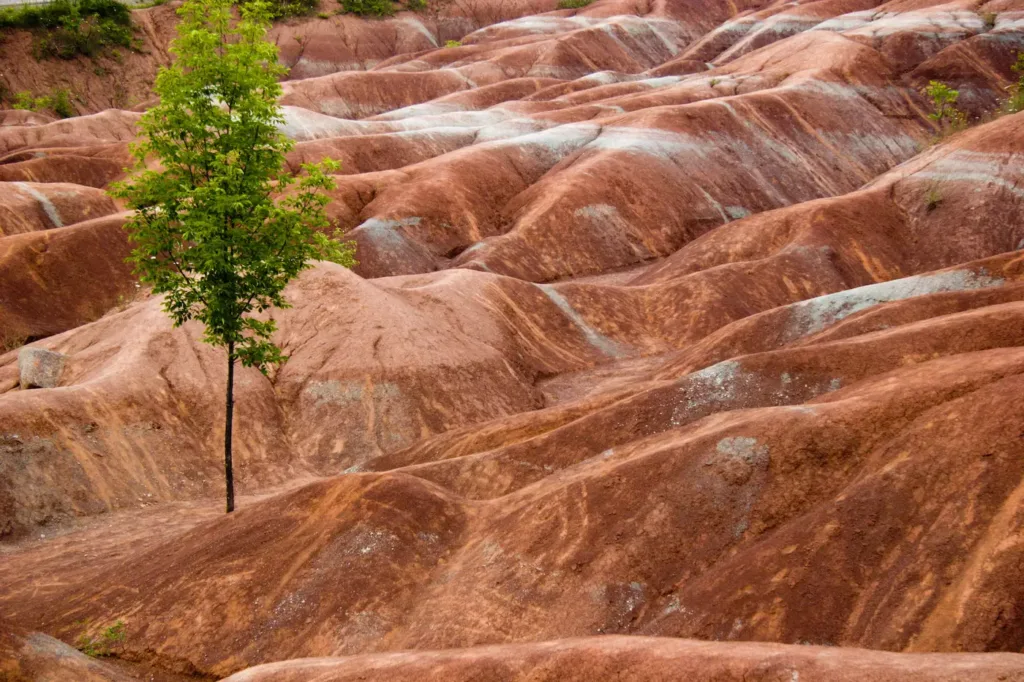
Overview of Conservation Efforts to Protect and Restore the Badlands:
Recognizing the ecological and geological significance of the Cheltenham Badlands, conservation efforts have been initiated to balance tourism with the preservation of this fragile landscape:
- Trail Management: Managed trails and boardwalks guide visitors along designated paths, minimizing the impact of foot traffic on sensitive areas.
- Visitor Education: Interpretive signs and guided tours educate visitors about the fragile nature of the landscape, encouraging responsible behavior.
- Access Control: Limiting visitor access during vulnerable periods, such as wet seasons, helps prevent further damage.
- Vegetation Restoration: Planting native vegetation helps stabilize the soil, reduce erosion, and restore the natural habitat.
- Erosion Control Structures: Strategically placed erosion control measures, such as barriers and retaining structures, help redirect water flow and protect sensitive areas.
- Tourism Management Plans: Implementing sustainable tourism management plans ensures that visitor numbers and activities are regulated to minimize negative impacts.
- Research and Monitoring: Continuous scientific research and monitoring provide insights into the changing landscape, guiding effective conservation strategies.
- Collaboration: Collaborative efforts involving government agencies, local communities, conservation organizations, and researchers work together to ensure the long-term protection of the Badlands.
By combining these conservation efforts with public awareness and responsible tourism practices, it is possible to strike a balance between sharing the wonder of the Cheltenham Badlands with visitors and preserving the fragile geological masterpiece for future generations to appreciate.
Cultural and Historical Significance of Cheltenham Badlands:
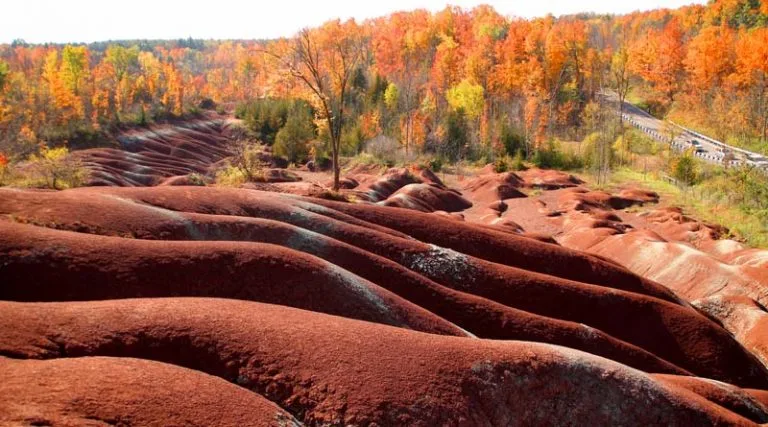
Overview of Indigenous History and Use of the Land:
The Cheltenham Badlands area has a rich Indigenous history that predates European settlement. Indigenous peoples, including the Mississauga of the Credit First Nation, have longstanding connections to the land. For these communities, the Badlands area likely held cultural, spiritual, and practical significance. Specific historical details about Indigenous use of the land may vary, but it’s important to acknowledge the deep connections they had and continue to have with the territory.
Discussion of European Settlement History:
The arrival of European settlers in the Cheltenham Badlands area marked a significant shift in land use and cultural dynamics:
- Agricultural Expansion: European settlers, particularly in the 19th century, transformed the landscape through agricultural activities. They cleared land for farming, leading to changes in the ecosystem and altering the natural environment.
- Impact on Indigenous Communities: European settlement often brought about displacement and disruption for Indigenous communities, affecting their traditional ways of life and cultural practices.
Examination of Cultural Significance for Local Communities:
The Cheltenham Badlands hold cultural significance for various local communities:
- Tourism and Recreation: The Badlands have become a popular tourist destination, attracting people from nearby cities and beyond. Local communities benefit from tourism-related activities, such as guided tours, educational programs, and local businesses catering to visitors.
- Educational Opportunities: The Badlands offer educational value for schools, universities, and nature enthusiasts. Learning about the geological processes that shaped the landscape and the fragile ecosystem can foster an understanding of the environment’s complexity.
- Cultural Identity: The Badlands contribute to the cultural identity of the region, often becoming emblematic of the area’s natural wonders. This unique landscape serves as a point of pride for local communities.
- Artistic and Creative Inspiration: The striking colors, patterns, and textures of the Badlands can inspire artists, photographers, and writers, contributing to the cultural creativity of the region.
- Connection to Nature: For many, the Badlands offer a space for reflection, connection with nature, and a sense of tranquility away from urban life.
- Challenges and Balance: While the cultural significance is undeniable, the challenge lies in preserving the Badlands’ integrity while accommodating the interests of both local communities and visitors. Striking this balance is crucial for ensuring the long-term cultural value of the area.
In conclusion, the Cheltenham Badlands carry cultural and historical significance that spans Indigenous history, European settlement, and the modern cultural landscape. Understanding the interplay between these historical layers and the contemporary uses of the land provides a comprehensive picture of the area’s importance to various communities and the broader cultural identity of the region.
Similar Geological Formations
While Cheltenham Badlands in Canada is a unique geological wonder, there are several other similar landscapes around the world that share certain features related to erosion, coloration, and distinctive formations. Here are a few examples:
- Red Rock Formations of the American Southwest (e.g., Arizona and Utah, USA):
- Unique Features: Iconic red rock formations sculpted by erosion, such as the Grand Canyon, Bryce Canyon, and Monument Valley.
- Geological Characteristics: These landscapes are primarily formed from sedimentary rock layers that have been eroded by the Colorado River and other natural forces.
- Uniqueness: The vibrant red and orange hues of these formations, combined with their intricate shapes and canyons, create an otherworldly and visually stunning landscape.
- Cappadocia, Turkey:
- Unique Features: Fairy chimneys, rock-cut churches, and surreal landscapes created by volcanic activity and erosion.
- Geological Characteristics: The area’s soft volcanic rock, known as tuff, was shaped by volcanic eruptions and later sculpted by wind and water.
- Uniqueness: Cappadocia’s distinctive rock formations have been hollowed out over centuries to create cave dwellings, underground cities, and uniquely shaped natural formations.
- Bryce Canyon National Park, USA:
- Unique Features: A series of amphitheaters filled with spire-like formations called hoodoos.
- Geological Characteristics: The hoodoos are primarily formed from the erosion of the Claron Formation’s limestone, creating colorful and intricate columns.
- Uniqueness: The combination of vibrant red, orange, and white rock layers, along with the tall, slender hoodoos, creates a visually captivating and otherworldly landscape.
- Quebrada de Humahuaca, Argentina:
- Unique Features: A UNESCO World Heritage site known for its colorful rock formations and cultural significance.
- Geological Characteristics: The area showcases sedimentary rock layers of various colors that have been shaped by wind and water erosion.
- Uniqueness: The vibrant colors of the rock layers, combined with the cultural history of the indigenous communities, contribute to the site’s unique character.
- Tsingy de Bemaraha National Park, Madagascar:
- Unique Features: Razor-sharp limestone formations resembling a stone forest.
- Geological Characteristics: The “Tsingy” formations are the result of water erosion and the dissolution of limestone over millions of years.
- Uniqueness: The spiky and jagged limestone pinnacles create an otherworldly landscape that is both breathtaking and challenging to navigate.
Each of these geological formations showcases the power of natural forces, such as erosion, water, wind, and volcanic activity, in shaping the Earth’s surface. While they share some similarities, their unique characteristics, including coloration, rock types, and specific formations, make each location a distinct marvel of geology and a testament to the diverse processes that have shaped our planet’s landscapes.
Conclusion

In conclusion, the Cheltenham Badlands in Ontario, Canada, stand as a remarkable testament to the dynamic forces that have shaped our planet over countless years. This unique geological wonder has captivated the interest of scientists, tourists, and local communities alike. Its distinct landscape features, vibrant hues, and intricate patterns tell a story of erosion’s creative power and the delicate balance between natural processes and human interaction.
From its formation through the gradual erosion of the underlying Queenston Shale to the challenges posed by increasing tourism and environmental sensitivity, the Badlands exemplify the interplay between geological history and modern conservation efforts. Through careful management, education, and collaboration, steps are being taken to ensure that this fragile landscape remains accessible for generations while preserving its ecological and cultural significance.
The Badlands also serve as a reminder that similar geological wonders can be found across the globe, from the red rock formations of the American Southwest to the fairy chimneys of Cappadocia and the razor-sharp limestone pinnacles of Madagascar. Each of these landscapes tells a unique story of Earth’s geological evolution, showcasing the diverse ways in which natural processes have shaped the world we inhabit.
In the end, the Cheltenham Badlands and their counterparts around the world inspire awe, curiosity, and a deep appreciation for the forces that have shaped our planet’s surface. They remind us of the intricate connections between geology, culture, history, and conservation, urging us to responsibly enjoy, protect, and learn from these remarkable natural wonders.
FAQ
What are the Cheltenham Badlands?
The Cheltenham Badlands are a unique geological formation in Ontario, Canada, characterized by their distinct red and orange rock layers and intricate patterns. They are the result of erosion on the underlying Queenston Shale formation.
How were the Cheltenham Badlands formed?
The Badlands were formed through a combination of natural processes including sedimentation, compaction, uplift, and erosion. Erosion by rain, wind, and freeze-thaw cycles has gradually sculpted the landscape’s striking features.
Where are the Cheltenham Badlands located?
The Cheltenham Badlands are located in the Caledon Hills near the town of Cheltenham, Ontario, Canada. The area is easily accessible from major cities like Toronto.
What gives the Badlands their unique coloration?
The red and orange hues in the Badlands’ rock layers are due to the presence of iron oxide, commonly known as rust. This iron compound oxidizes over time, giving the rock its distinctive colors.
Can visitors explore the Cheltenham Badlands?
Yes, visitors can explore the Badlands through designated trails and viewing areas. It’s important to follow posted guidelines to minimize erosion and protect the delicate landscape.
Are the Cheltenham Badlands fragile?
Yes, the Badlands are fragile due to the soft nature of the Queenston Shale. Visitors should stay on designated trails and avoid climbing or disturbing the rock formations to prevent further erosion.
How has tourism impacted the Badlands?
Increased tourism has led to additional erosion due to foot traffic and other human activities. Efforts are being made to balance tourism with conservation to protect the landscape.
Are there conservation efforts in place for the Badlands?
Yes, conservation efforts include managed trails, education programs, access restrictions during sensitive periods, erosion control measures, and collaborative efforts among various stakeholders.
Can the Cheltenham Badlands be visited year-round?
Yes, the Badlands can be visited year-round, but it’s important to check for any seasonal closures or restrictions. Different seasons offer varying views of the landscape.
What is the cultural significance of the Cheltenham Badlands?
The Badlands hold cultural significance for both Indigenous communities and local residents. They contribute to local identity, tourism, education, and artistic inspiration, while also prompting discussions about responsible land use and conservation.


























